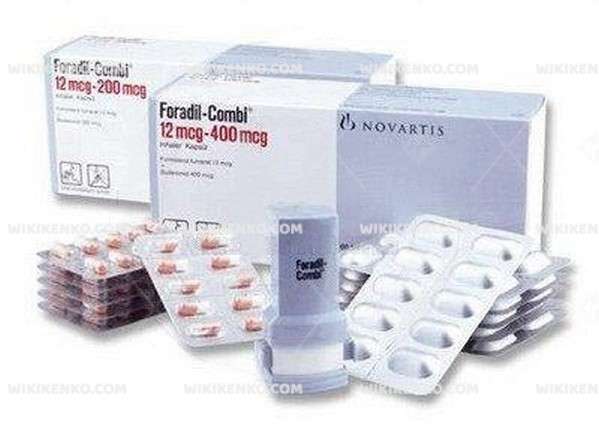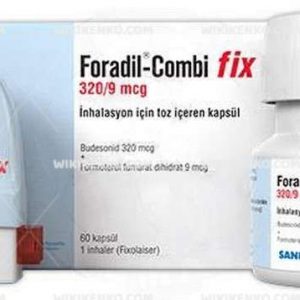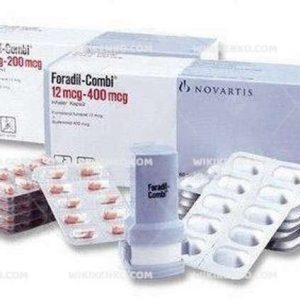Foradil Combi Inhaler Capsule 12 Mcg/400Mcg
In this comprehensive guide, we unveil the key aspects of Foradil Combi Inhaler Capsule 12 Mcg/400Mcg, a medication crucial in managing obstructive airway diseases. Dive into the world of its ingredients, usage, dosage, potential side effects, precautions, and alternatives to gain a comprehensive understanding of this vital medication.
| Dosage form | |
|---|---|
| Pack size | |
| Potency | 12 Mcg/400Mcg |
| Manufacturer | |
| Origin | |
| Generic Name (Ingredient) | Formoterol Fumarate Dihydrate 12 Micrograms |
Assuming your emergency circumstances for this product, visit Urgent Quotation page. Besides, for any pharmaceutical questions, please ask us in the comments section.
Description
Foradil Combi Inhaler Capsule 12 Mcg/400Mcg plays a pivotal role in the treatment of obstructive airway diseases. It boasts a unique combination of two active ingredients: Budesonide and Formoterol.
Usage and Significance
Foradil serves as a long-acting bronchodilator, effectively relaxing the muscles within the airways to enhance breathing. Its applications are diverse, extending to:
- Asthma Management: Foradil is a valuable tool in the prevention of asthma attacks, particularly in adults and children aged 5 and above. It also proves effective in mitigating exercise-induced bronchospasm.
- COPD Control: Individuals with chronic obstructive pulmonary disease (COPD), encompassing conditions like emphysema and chronic bronchitis, find relief through Foradil. It serves to prevent bronchospasm in this demographic.
Dosage Guidelines
For optimal results and safety, adhering to prescribed dosages is crucial. Typically, adults and children aged 5 and older are advised to inhale the contents of one 12-mcg Foradil capsule every 12 hours, utilizing the Aerolizer Inhaler. It’s essential to note that the total daily dose should not surpass one capsule twice daily, totaling 24 mcg daily.
While Foradil proves immensely beneficial, it’s important to be aware of certain warnings associated with its usage. Notably, in individuals with asthma, there may be an increased risk of death or hospitalization. However, this risk isn’t well-defined for those with COPD. Should you experience worsening breathing problems or notice reduced medication efficacy, prompt medical attention is advised.
Foradil Side Effects
Foradil usage may result in common side effects, which include:
- High Blood Sugar: Recognized by increased thirst or urination, hunger, dry mouth, fruity breath odor, drowsiness, dry skin, blurred vision, and weight loss.
- Low Potassium Levels: Manifesting as leg cramps, constipation, numbness or tingling, muscle weakness, or a limp feeling.
- Headache
It’s important to emphasize that while these side effects are potential, individual experiences may vary. Some individuals may not encounter any side effects at all.
Precautions and Allergies
Prior to using Foradil, several precautions must be taken into account:
- Allergies: Individuals allergic to Formoterol should abstain from using Foradil.
- Medical History: Inform your healthcare provider of your medical history, including heart disease, high blood pressure, epilepsy, thyroid disorders, pheochromocytoma (adrenal gland tumor), aneurysms, and any history of food or drug allergies.
- Consultation is Key: Always consult with a healthcare provider for comprehensive information and personalized guidance concerning Foradil usage.
Alternative Medications to Consider
For those seeking alternatives to Foradil, several options are available. These include:
- Xolair (omalizumab): An injectable medication effective in treating allergic asthma, nasal polyps, and chronic conditions.
- Dupixent (dupilumab): Administered via injection and beneficial in managing asthma, eczema, and various inflammatory conditions.
- Symbicort (budesonide / formoterol): A medication containing formoterol, similar to Foradil.
- Advair Diskus (fluticasone / salmeterol): Another combination medication useful in treating asthma and COPD.
- Breztri Aerosphere (budesonide / formoterol / glycopyrrolate): A triple combination medication prescribed for COPD.
- Spiriva (tiotropium): A long-acting bronchodilator catering to COPD management.
The choice of alternative medication should be made in consultation with your healthcare provider, considering individual health status, requirements, and potential side effects.
Conclusion
Foradil Combi Inhaler Capsule 12 Mcg/400Mcg stands as a cornerstone in the management of obstructive airway diseases. Its unique formulation, comprehensive benefits, and precautionary considerations make it a vital component in enhancing respiratory health. However, the importance of consulting with healthcare professionals cannot be stressed enough when it comes to medication usage. Their guidance ensures safe and effective treatment, aligning with your specific health needs.
Summary
| Aspect | Information |
|---|---|
| Active Ingredients | Budesonide and Formoterol |
| Usage | Long-acting bronchodilator for obstructive airway diseases |
| Dosage Guidelines | Adults and children 5 years and older: 1 capsule every 12 hours, not to exceed 24 mcg daily |
| Common Side Effects | High blood sugar, low potassium, headache |
| Precautions and Allergies | Allergic to Formoterol, medical history, consult healthcare provider |
| Alternative Medications | Xolair, Dupixent, Symbicort, Advair Diskus, Breztri Aerosphere, Spiriva |
Use the form below to report an error
Please answer the questions as thoroughly and accurately as possible. Your answers will help us better understand what kind of mistakes happen, why and where they happen, and in the end the purpose is to build a better archive to guide researchers and professionals around the world.
The information on this page is not intended to be a substitute for professional medical advice, diagnosis, or treatment. always seek the advice for your physician or another qualified health provider with any questions you may have regarding a medical condition. Always remember to
- Ask your own doctor for medical advice.
- Names, brands, and dosage may differ between countries.
- When not feeling well, or experiencing side effects always contact your own doctor.
Cyberchondria
The truth is that when we’re sick, or worried about getting sick, the internet won’t help.
According to Wikipedia, cyberchondria is a mental disorder consisting in the desire to independently make a diagnosis based on the symptoms of diseases described on Internet sites.
Why you can't look for symptoms on the Internet
If diagnoses could be made simply from a textbook or an article on a website, we would all be doctors and treat ourselves. Nothing can replace the experience and knowledge of specially trained people. As in any field, in medicine there are unscrupulous specialists, differences of opinion, inaccurate diagnoses and incorrect test results.





Reviews
There are no reviews yet.